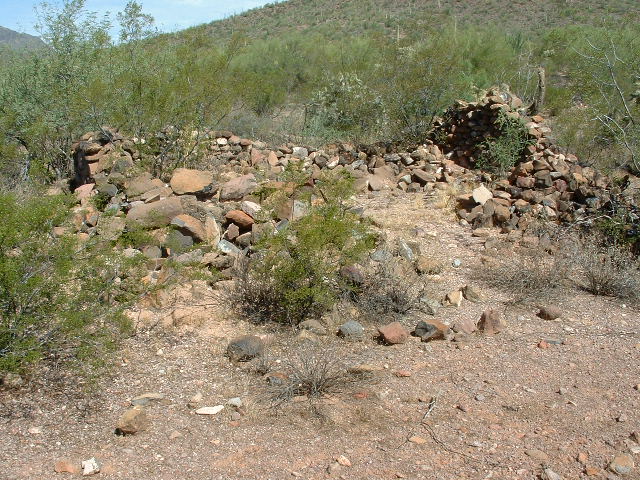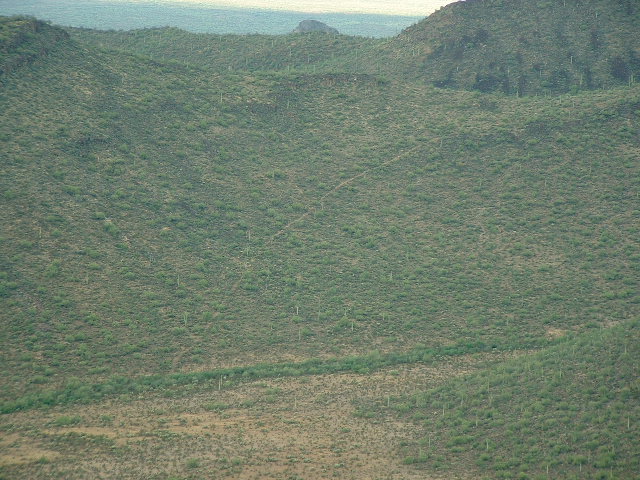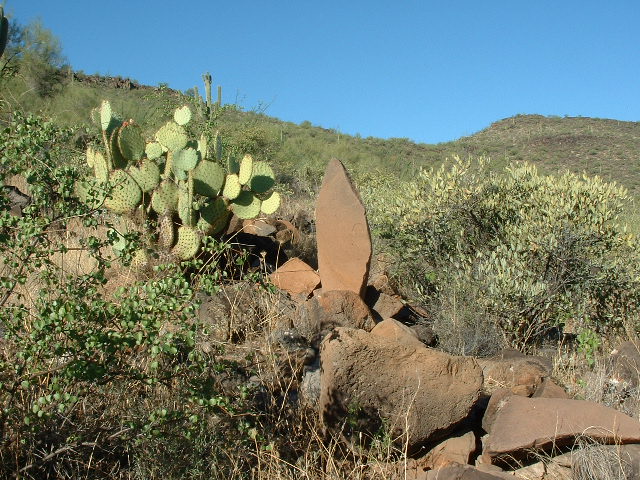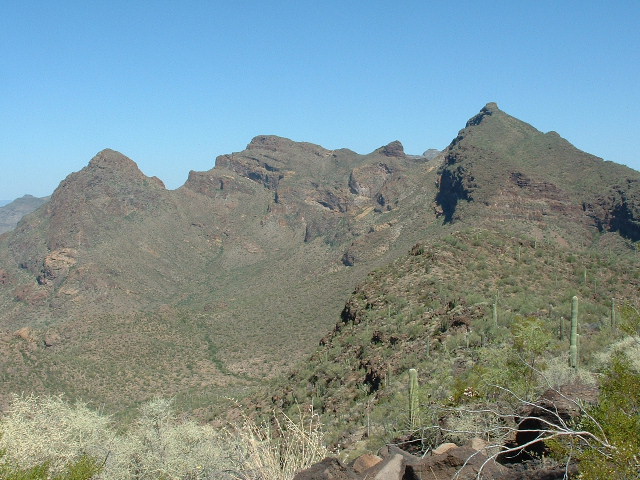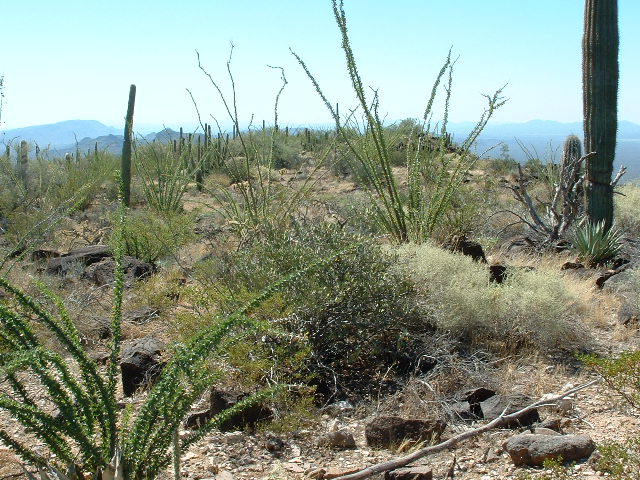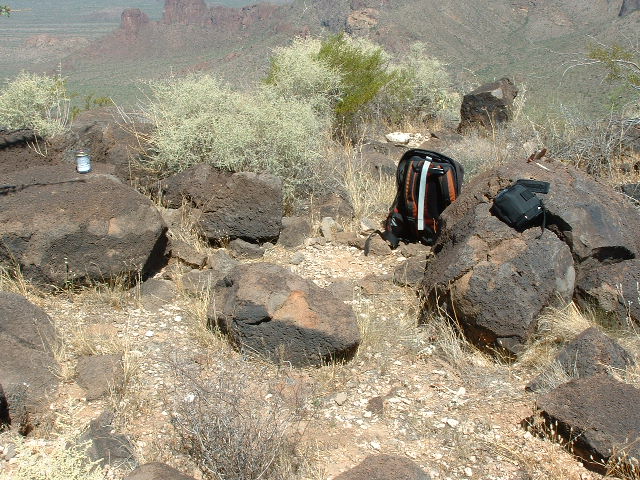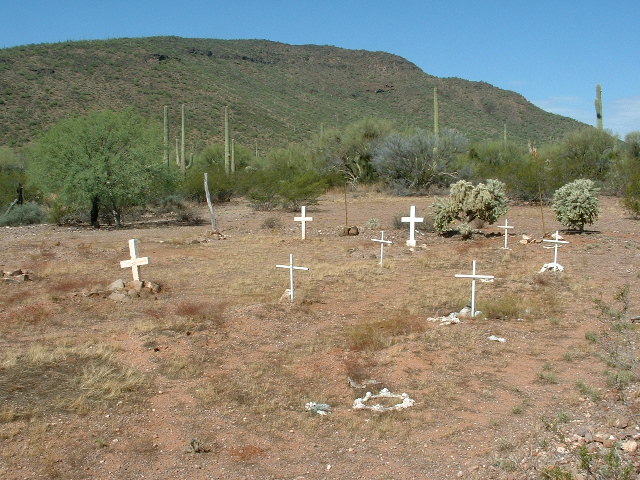One August morning several years ago, I left my home in Tucson, Arizona and drove west into the night. A full two hours and 100 miles later, I had driven across most of the Indian reservation and arrived at a lonely highway junction. The sign pointed south to the village of Gu Vo. This wasn’t my first visit to the area, far from it. A spectacular group of mountains called the Ajo Range had drawn me back, time and time again, to chip away at its 46 summits. My goal today was a group of peaks I had been postponing for a long time. They presented some real challenges, and I had spent hours on the computer studying the maps, trying to figure out a way to best approach them. Here follows my account of how I attacked them, and what happened to me on that fateful day.
A drive of 15 miles took me to Gu Vo, its inhabitants still asleep in their beds at the pre-dawn hour of 4:30 a.m. Continuing south another 6 miles on the paved road, I arrived at a turnoff on to a dirt road. I was getting close. Two and a half miles farther south, I turned west on a lesser road. This in turn deteriorated to a rough four-wheel-drive track which ended a mile and a half later. Along this last stretch, I passed the remnants of the long-abandoned settlement of Siovi Shuatak. There wasn’t much left of the place.
The road had become so bad that I doubt I could have continued, but mercifully it ended in a steep gully. Setting the hand brake, I shut off the engine and climbed out. It was 5:45 a.m.
While getting my pack ready, I made my second mistake of the day: I only took three 20-ounce bottles of drink with me. For some bizarre reason, probably a desire to travel “light and fast”, I foolishly assumed that’d be enough. Huge mistake. Although I knew it’d be over 100 degrees, I did it anyway.
The sun had not yet risen when I walked away from the truck. Even though I was crossing flat desert with the advantage of no sun beating down on me, I felt strangely warm and slightly light-headed. In case you’re wondering what my first mistake of the day was, here it is – I was already dehydrated. I didn’t know it at the time, but the luxury of hindsight has made it very clear. As if it were yesterday, I can recall with crystal clarity the sensation of being a bit spaced out, even wondering to myself what was going on, and thinking maybe I should turn around and go home. But I didn’t, instead continuing on. That was my third mistake, one I would live to regret.
After nearly two miles, I came to my first goal of the day. Peak 2750 rose abruptly, surrounded on all sides by flat desert. The simple climb of its northeast side left me strangely tired. Normally, it would’ve been a cakewalk. I went through the motions of filling out a register and building a cairn around it, then started down its southeast side. Before I’d gone fifty feet, a familiar sound startled me and I jumped back. There in front of me sat a western diamondback rattlesnake, shaking its tail to warn me. Jeez, I had almost stepped on it. That woke me up, I’ll tell you. I gave it a wide berth and continued down the mountainside to the desert floor.
A short walk brought me to the base of a slope and to a feature I had spotted on a previous trip into the area. From afar, it looked like a faint road angling up the mountainside, heading up and to the right. Here is a telephoto shot of it taken from a nearby mountain a few weeks earlier.
As I neared it, I was surprised to find a path, perhaps three feet wide and built to last. It had been designed by its builders to resist erosion, providing a level walking surface up the gentle slope. It had almost certainly been put in back in the 1880s or 1890s in Arizona’s mining heyday, probably to access a mineral deposit and allow transport of equipment and ore by mules. Here is a sort of a stone marker where it started.
Even though I was trying to ration my liquid, I had already finished my first bottle. My thirst was fierce. Fortunately, the path was easy to follow, and it held for about a mile. It eventually petered out at around 2,700 feet elevation. By then I was on the southeast ridge of Peak 3072.
Continuing on, I followed a ridge which marked the boundary between the Indian reservation and Organ Pipe Cactus National Monument. By the time I reached the top of Peak 3072, I had drunk my second bottle.
I couldn’t get enough – if I’d had a gallon, I would’ve drunk it all on the spot. Thirst consumed me. I remember thinking really hard at this point – what should I do? I had one summit left, and it was still a ways off. If I were to do it now, this area of peaks would be finished and I wouldn’t have to come back again. On the downside, climbing the next peak would put me farther away from my truck, and I only had twenty ounces left to drink. It was only 9:15 a.m., yet it was almost 100 degrees. The sun beat down unmercifully as I stood there by the cairn I had built. What the hell – let’s go for it, get that last peak! With my already-impaired thinking, that was my next and worst mistake.
Descending to the saddle at 2,750 feet, I then started up and over Point 2857, a sizable bump along the ridge. I then had to lose another 200 feet of elevation before starting up the southeast slope of Peak 3210 – trudged is more like it. It seemed like I moved in slow-motion to cover that last 600 vertical feet. As I got close to the summit, I felt a twinge in my right thigh, which I knew to be a sign of real trouble. Oh god, please don’t let me cramp up! I knew that if that happened, I’d be crippled out there – making it back to my truck before I succumbed to heat and thirst would be a huge challenge. Favoring that leg, I kept going until the slope lessened and I walked the final few feet to the summit. I’d made it! Even though I felt the worst was over, an odd idea popped into my head. I took a photo of myself, thinking that if I didn’t make it back, at least there would be a last picture of me for posterity when they found my camera. I didn’t linger. Making a last cairn, I put my register in it and got ready to leave.
It was now 10:40 a.m. All I had to do now was drop 800 feet east to the desert floor and make it back to my truck. Several times on the descent, I could feel that muscle on the verge of blowing out. Thankfully it didn’t, and I stepped on to the flat desert floor.
Feeling more confident now, I started across this three-mile stretch of flat desert. My truck wasn’t visible but I knew where to find it, hidden behind a distant ridge. I was now on the sun’s anvil, just putting one foot in front of the other, trying to make it back before the heat did me in. My thinking was getting fuzzy, but I knew where I had to go. I had nothing left to drink, my spit was a thick paste. The heat was palpable – I could taste it, smell it, as it shimmered off the desert floor. I walked along in a daze.
By noon, I was only half a mile from the truck. It was just around the next corner – the end was in sight. Then it happened. Because of the heat, the exertion and my dehydration a wave of cramping hit me all at once. Ordinarily, if I get a cramp I try to massage it out and try to stretch the muscle, but I had pushed myself too far. I was hit with cramps in both calves, and two in each thigh, simultaneously. It was my worst nightmare, and it was terrifying. Within moments, I found myself lying on the ground screaming in agony, my legs contorted with the massive cramping. I crawled into the shade of a nearby mesquite tree and tried everything I could think of to make the cramps go away. To this day, I can’t recall exactly how it came about, but some twenty minutes later the cramping had subsided enough that I staggered to my feet. I was spent. My legs still burned, I had shouted myself hoarse, tracks of tears stained my dust-covered face, but the good news was that I was on my feet once again.
I limped the last half- mile, rounded a corner and there was my truck – a more beautiful sight I had never seen. It was not my day to die. When I reached the truck, I unlocked the rear hatch and put down the tailgate. You’d think I’d have immediately opened the two small coolers in the truck and drunk my fill. I had water, juice, gatorade, soda, and plenty of it. But I didn’t drink. My judgement was so impaired that all I did was lean over the tailgate, resting my head on my arms and close my eyes. Maybe fifteen minutes passed before I came to my senses, then sat on the tailgate. I remember slowly swinging my legs back and forth, sipping gatorade. I drank a couple of quarts, maybe three.
By now I was feeling clearer, so I closed up the truck, got into the cab and fired it up. I cranked the AC up full blast, turned the truck around and headed down the rough road. My legs felt like they were ready to cramp up again with the simple effort of operating the pedals to change gears and to brake. I decided to leave it in second gear and not shift at all, pounding my way over rocks and whatever else lay in my path to just keep moving. En route, I passed the cemetery that was used by the inhabitants of Siovi Shuatak – I was glad I wasn’t going to be added to it.
Before long, I reached the better road and took it out of four-wheel-drive, driving more easily along the flat, smooth dirt road heading north. I was sure the worst of it was behind me, or so I thought, when I felt my legs on the verge of cramping up again. I slowed down, put it into neutral and set the hand brake before the cramps hit. I vaguely remember pitching out of the door on to the dirt. The next thing I knew, I was lying behind the truck, partly under it in the shade, the engine still running. Another 45 minutes had passed! At least the cramps were gone. I checked the temperature – it was 106 degrees in the shade.
Once again, I got to my feet and back into the truck.. It was one mile to the paved highway, and I felt if I could get there, things would somehow be better. I started driving again, but hadn’t gone but a few hundred yards when my next trial began. My eyesight became dim, and within moments I couldn’t see at all! It was as if I had gone blind – all I could do was close my eyes. I sat with the AC going full blast, sipping more drinks. Another half hour passed. I would open my eyes from time to time to see if my vision was returning – surprisingly, I wasn’t alarmed by this. Gradually, my eyesight returned to normal, and I started driving again. When I reached the pavement, I just kept on going, but driving slowly. Ten miles passed, and I was approaching the main highway, Arizona 86, when I saw a vehicle approaching me from the north. I was probably only doing 30 mph in a 55 mph zone. They must have noticed my slow speed, because they too slowed down. It was then that I recognized it as a Border Patrol vehicle, and, better yet, in it were two agents I had met before on a few occasions. As soon as they saw me, they asked what was wrong, saying that I looked bad. I told them about my day. They offered to park my vehicle and drive me into the clinic in Ajo for help. Thanking them, I said I thought I could make it back to Tucson okay. They wished me well and we parted company.
Two hours later, as I approached Tucson, I made a cell-phone call to my friend Paul, just to say hello. As soon as he heard my voice, he knew something was wrong. He asked me what was going on, had I been out climbing? I gave him the short version of my day and he became very concerned. He insisted I pull into a gas station nearby and wait for him. I did, and he arrived soon after. His wife, who worked in the medical field, had told him to check my pulse. It had been five hours since I had stopped climbing, all the while inactive, and my resting pulse was still 110. Paul was alarmed. He had his son drive my truck while he ferried me in his vehicle – we convoyed to my home. I could barely walk to my front door. All I told my wife was that it had been a challenging day.
I spent the evening drinking a lot to re-hydrate myself, vegging out in front of the TV as Hurricane Katrina slammed into the Gulf Coast and killed so many. A doctor friend of mine who is also a climber told me in later days that I was very lucky my kidneys didn’t shut down. As it was, I didn’t pee until the following morning and it was dark orange. I was much luckier than the poor victims of the hurricane – it was not my day to die. My close call changed me forever. Now, whenever I go out climbing, I always carry more than I can drink and I make sure it is a good electrolyte replacement.
Please visit our Facebook page at: https://www.facebook.com/pages/Desert-Mountaineer/192730747542690

